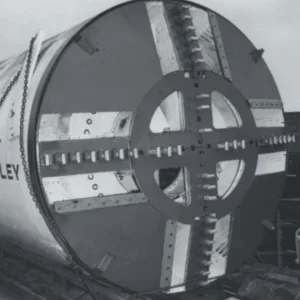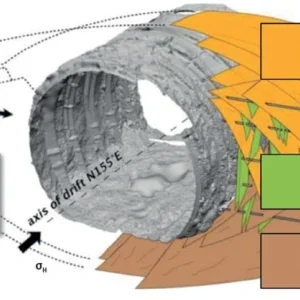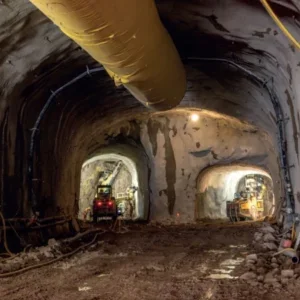
Back in the late 1990s, the tunnelling industry was reeling from high profile incidents on tunnels all over the world from fire and flooding on Denmark’s Storebaelt Crossing to the 1994 Heathrow Tunnel Collapse. In response to fears that tunnel projects were becoming uninsurable, the Association of British Insurers, and the British Tunnelling Society joined forces to create a new benchmark for best practice. Published in 2003 the “Joint Code of Practice for Risk Management of Tunnel Works in the UK” was followed by an international version in 2006 named the “Code of Practice for Risk Management of Tunnel Works”. These codes became known worldwide as the Tunnel Code of Practice, or TCOP.
Taking a lead on the review of the TCOP is the International Tunnelling Insurance Group (ITIG), which includes construction underwriters and tunnelling engineers including representatives from the BTS, ABI as well as the International Tunnelling Association (ITA) and the International Association of Engineering Insurers (IMIA). “With nearly 15 years of experience since the first publication of the JCOP the ITIG has been re-energised with the aim of reviewing the penetration and effectiveness of the code around the world,” says Patrick Bravery, chairman of the ITIG.
Review will be carried out in the coming months with the support of professional bodies via a short survey seeking feedback on the application and experiences of the code. The scope of the review includes; the experience of tunnelling projects before and after the release of the code and with and without application of the code; regional variations in the application of risk management methods; and other developments in risk management practices and how they may have impacted the environment in which tunnelling projects have been delivered. “Once the responses to the survey have been reviewed, the ITIG will consider whether any revisions to the code are required or appropriate. Preliminary areas for consideration include separating the principle of the code from the detail, adding a section on instrumentation and monitoring, recognising the role of BIM and more closely aligning the code with other recognised risk standards,” explains Bravery.
Insurers say that development of the code was an important step in building confidence in tunnelling projects. “It has led to tunnelling projects being more insurable today,” explains Cedric Wong, senior engineering underwriter and vice president of projects and global markets at Swiss Re Corporate Solutions. “It doesn’t guarantee success but it gives the best possible chance of a successful outcome if it is followed and implemented. When we are presented with a tunnelling project by a broker, we look at the information provided by the client, contractor and we benchmark it against the TCOP,” he says. “We can assess if they have taken a risk based approach in choosing the original tunnel alignment, have they procured based on both quality and cost, have established a risk management framework, are they using risk registers, have they got design checkers? We assess the project and if it aligns with the code and if we determine that risk management is solid there is a good chance of insurability.”
Wong points out that the wider insurance market today is much more competitive than it was when the TCOP was published. Back in 2003 the whole insurance industry was reeling from the financial consequences of the tragic terror attack on New York on the 11th September 2001. The massive claims running into tens of billions of dollars, led to a hardening of the market – making insurance less available and more expensive. This, in conjunction with several high profile catastrophic tunnel failures made tunnels almost uninsurable.
Today is a different story. “It is a good time for tunnel projects to buy insurance. With interest rates and return on investment at all time low, capital is flooding into the insurance sector as it produces good returns on equity in comparison to other investment options.” says Wong.
MANAGING RISK
At the same time, some landmark projects are proving that tunnelling risk can be successfully managed. “The positive work done on projects like Crossrail gives insurers a good deal of confidence that technically complex tunnelling risk can still be undertaken,” says Wong.
Complexity is inevitable when building a new GBP 15bn (USD 20bn) railway with 42km of new railway tunnel using eight TBMs, along with construction of a further 18km of station tunnels and interchanges as well as 9 new stations beneath the UK’s capital city – making it inherently risky. “The mitigating factors to that were that London had relatively successful projects before with the Jubilee Line extension and the Channel Tunnel Rail Link. The geological model of London is really well known. The presentation of the Crossrail project in terms of benchmarking against the TCOP showed a really high level of compliance which gave us confidence that there was a high chance of success on the project,” says Wong whose firm Swiss Re Corporate Solutions took the lead position on the insurance programme. “The other factors that convinced us was the level of retention that the client was willing to take, set deductibles reasonably high. The higher the deductible is the lower the insurance premium and what that demonstrates to us is a real confidence in their own risk management.” At the same time, Crossrail were interested in the insurers’ risk management activities, which Wong describes as a complementary risk management regime. “They were keen for us to share our experience of engineering and construction claims and the associated lessons learnt from projects around the world. Throughout the changing risk profile of Crossrail, we select the industry risk experts that we think are most suitable for the job. These are experts, people who can add value.”
This risk engineering programme is a critical part of such projects for the insurance industry. On Crossrail for example there are 28 different insurers backing the scheme who are reassured thorough the risk management approach of the leading insurer. But before any of these firms could be appointed, Crossrail needed to work with a broker to determine the appropriate insurance structure and levels of cover required for this mega- project. And its sheer scale meant that it had to be tackled differently from the outset with the contract being tendered through the Official Journal of the European Union (OJEU).
“Brokers had to go through a tender to demonstrate that they had the technical knowledge, ability and experience to advise Crossrail on the appropriate insurances for the project,” explains Sarah Bickerstaff, executive partner in construction services at the tender winning insurance broker Arthur J Gallagher. “We learned about what they were going to build and really became part of the delivery team. We worked with Crossrail to understand what their appetite for risk was, what their approach was going to be and to explain to them their options and the pros and cons,” she says.
The earliest fundamental aspect of this was whether Crossrail would procure Contractors’ All Risk (CAR) and Third Party Liability (TPL) insurance through an owner controlled, or a contractor controlled route where the contractor places the insurances for their element of the contract. For a scheme the size of Crossrail, a contractor controlled policy would have meant a large number of different policies with a range of excesses and cover. “It wouldn’t give Crossrail control of the cover and the quality of insurer and the budgetary stability in terms of premium. The whole aim was to keep the project on target, on budget and so therefore Crossrail took control of the insurances,” says Bickerstaff.
PREMIUM CERTAINTY
Contractors’ All Risks (CAR) insurance is the cover for material damage that could occur on a project. The project also required third partly liability (TPL) insurance covering any damage to third parties such as buildings, infrastructure or people affected by an incident. For Crossrail it was crucial to have high quality cover, over the lifetime of construction which was nine years, and with fixed premiums to give long term budget certainty. This was a challenge for the insurance industry which typically introduces break clauses in project insurance policies which allow insurers to re-evaluate their position throughout the construction period. “One of the key drivers was certainty of cover for the entire nine-year construction period. This had never been achieved in the insurance market before,” says Bickerstaff. “They needed to have absolute confidence that the insurers would support the programme to the end of the project irrespective of claims experience.” It’s typical that a panel of insurers would be required to cover a project of this size. With such high values of risk running into billions other insurers would need to participate in the project. “It is like layers of a cake really. You buy elements of cover in acceptable tiers up to a level where Crossrail thought they had bought adequate protection given the likelihood of loss and given the potential severity of that loss,” says Bickerstaff.
To ensure that the level was appropriate AJ Gallagher provided Crossrail with benchmark figures from other major projects before taking the scheme to market. By early 2009 Crossrail were ready to begin procurement, which by moving through the OJEU process, was being undertaken in a new way. “The challenge for us as brokers was that this was the first major project insurance policy to be procured through the OJEU rules. It had to be done through a data room so all firms had the same access to information. This is a people driven industry so to get them all to go to an electronic data room and pull the information out was something that we had to educate the market on,” says Bickerstaff.
“It was a big change in how insurance was procured. Gallaghers handled it well and now it is pretty common place for projects to go through an OJEU process – especially if they are government backed,” says Wong.
After a series of awareness raising presentations to insurers, invitations to tender were published with a broad form of policy wording. Insurers that expressed an interest were taken through a rigorous checking procedure on financial rating and competence to ensure that they had the experience and capability on risk management and claims to underwrite the risks. Tenders were then evaluated against the criteria determined by Crossrail such as breadth of cover, the requirement for a nine-year policy and at the end of this entire process the clear leader was Swiss Re Corporate Solutions, the commercial insurance arm of the Swiss Re Group. Other firms were then invited to take positions on both the CAR policy and the TPL policy. In the end 28 insurers participated in the project, with nine underwriting the material damage risk under the CAR policy and a further 19 on the TPL cover behind the Swiss Re Corporate Solutions lead terms.
Another unique aspect to the Crossrail insurance arrangements was the structure of the loss adjustment panel. These experts are brought in to examine evidence and assess losses in the event of a claim. “For Crossrail, it was not as simple as saying ‘we will employ this loss adjustor’ for the whole project because they may not have the resource to deal with claims across the whole alignment, so we packaged it into three sections,” says Wong. Once this approach was established Crossrail then adopted the same approach for claims below the level of the insurance excess using the same loss adjustors which reduced the interfaces. “It created a seamless solution to claims,” says Bickerstaff.
Eight years later and with the tunnelling complete, the Crossrail project has been truly ground breaking from a risk management and insurance point of view. But it isn’t over yet – the insurance coverage continues until the rail is operational – and the risk profile has evolved from a tunnel collapse type failures to fire risk within the completed stations – which is the maximum exposure scenario for insurers.
Although Crossrail managed to undertake this challenging construction work successfully, other projects have not been without incident, with tunnel collapses still occurring during construction around the globe. Such incidents have big implications for projects and third parties and ultimately the construction insurance market. “That is why understanding the effectiveness and penetration of the TCOP is really an important and valuable exercise,” says Wong.
“The [TCOP] enabled the insurance market to come back to the table with regard to covering tunnel projects. The tunnelling industry recognises the benefit of risk management in delivering successful outcomes –supported by other stakeholders such as insurers – whose confidence in the industry is maintained. What you want is to keep encouraging the insurance market to come to the table to insure those risks going forward and the only way is through the review of the code and making sure that it keeps up with not just physical design but all the changes that are happening out there,” says Bickerstaff.







